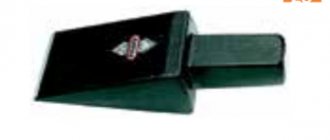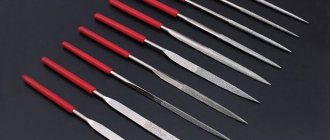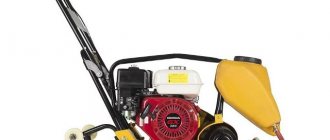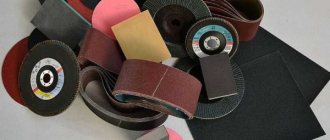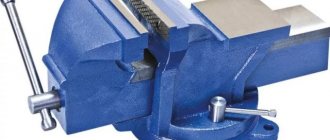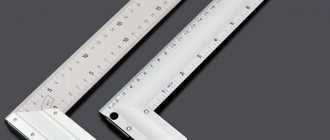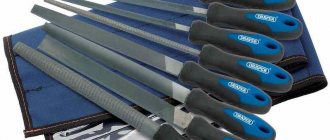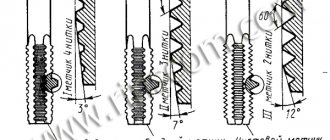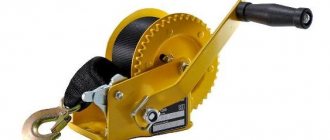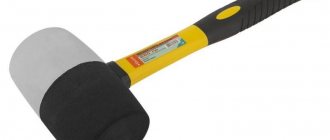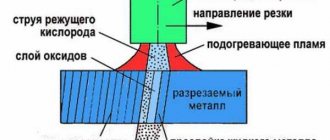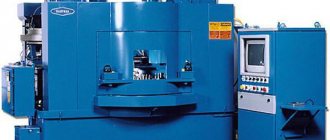One of the most structurally simple and widespread measuring instruments, which is distinguished by its versatility, high accuracy of readings and the ability to measure internal and external diameters, is a caliper.
Among its many types, which also have different sizes, you can find options with a truly minimal error.
The tool itself is actively used in everyday life, and in mechanical engineering and turning it is completely impossible to do without it.
Read more about what a caliper is, what it is capable of, what it is made of, what it comes in and which one to choose, below.
Purpose and principle of operation
The purpose of a caliper is to take high-precision measurements inside and outside the objects being measured, as well as the depths of various holes.
The peculiarity of the tool is its versatility.
Shtangel - a common name for calipers among those who constantly use them, is a common abbreviation of the word.
This tool can measure the outer and inner diameters of round and cylindrical objects, such as nuts and bolts, and is suitable for internal groove measurements in all respects.
The principle of measuring with a caliper is to determine the size based on the position of the measuring frame, which moves freely along the rod with a printed scale.
The size value itself is determined by the coincidence method, and its accuracy, depending on the accuracy class itself, can reach hundredths of a millimeter.
The design of the meter or what the bar consists of
The instrument got its name from the word rod, since it is structurally a ruler with a rod with a scale moving along it. Let us consider in detail what structural elements a caliper consists of in order to ultimately understand how to use it correctly. The main structural elements of the device include:
- Fixed bar with scale in millimeters. The fixed rod has two types of jaws for measuring the internal and external dimensions of parts
- Movable bar with vernier scale. Its design includes a second pair of jaws for taking measurements from workpieces. One or two vernier scales can be applied to the movable rod. One scale, which is usually located at the bottom, allows you to calculate dimensions up to hundredths of millimeters, and the second at the top - for measuring thousandths of millimeters
- A latch or clamp is a spindle that blocks the displacement of the movable frame. This is convenient when the jaws are attached to the part and you need to calculate the values
- Depth gauge - a retractable thin bar that makes it possible to calculate the depth of grooves and grooves on workpieces
Before learning how to use a caliper, it is necessary to take into account that the types of devices under consideration are different in the method of indication, that is, the calculation of information. The simplest option is an analog or mechanical caliper, the design of which is shown in the photo. Let's look at what calipers are and how they differ in detail.
Device, characteristics and properties
If you use your imagination, then externally the bar looks like a symbiosis of a hammer and a ruler.
The classic instrument consists of the following elements:
- Barbell with marked scale. The maximum measurement value depends on the length of the rod.
- The measuring frame is a movable part of the rod that can move along the rod. It has a vernier scale on it, allowing you to determine fractions of a millimeter. A spring with a fixing screw is installed inside the frame, pressing it against the rod, which reduces the measurement error, which can increase as a result of the skew of the moving part relative to the stationary one. Instead of a vernier, a dial scale or a small digital display may be installed, depending on the caliper model.
- Fixed jaw - structurally is part of the rod or is rigidly fixed to it, and is located on one side of the tool.
The working area is the inner edge of the stationary sponge; during measurements, it is tightly applied to the object being measured. - The movable jaw is structurally part of the frame or is rigidly fixed to it. The working part is also internal, and the part itself is located exactly opposite the fixed jaw in such a way that when the frame is moved, the edges of both jaws touch. In this position, the zero parameters of the rod and vernier scales must coincide.
- The retractable bar is a structural part of the measuring frame, its purpose is to measure the depth of objects.
The considered design, which has one-sided jaws, allows one to determine only the external dimensions of objects.
For internal measurements, you will need a caliper with double-sided jaws.
The second ones, as a rule, are smaller in size, located similarly to the first ones, but on the opposite side of the bar, and the working edges are the outer edges.
Material
Metal calipers are made mainly from carbon and stainless steel, low-alloy tool steels 9ХС, ХВГ.
Stainless steel tools are a classic, however, in the production of modern booms, composites are also used, for example, based on carbon fiber and polymer resins.
Dimensions
Typical sizes of classic calipers:
- Jaw length for external measurements: 35 – 300 mm.
- Jaw length for internal measurements: 6 – 22 mm.
- Measuring range – up to 2 m.
- Vernier length: 9 – 39 mm.
- Weight (depending on material and dimensions): 0.2 – 8.9 kg.
Models with a measuring range of up to 5000 mm can weigh more than 35 kg.
GOST
The following current GOSTs regulate both the verification and production of calipers:
- GOST 166-89 – defines technical conditions
- GOST 8.113-85 - determines the verification procedure
Accuracy
Vernier calipers are characterized by several accuracy classes:
- class - error is 0.05 mm (twentieth of a millimeter)
- class - error is 0.1 mm (tenth of a millimeter)
For high-precision measurements, a completely different instrument is used - a micrometer.
To clearly show what the accuracy class affects, it is enough to assume that it is necessary to determine the diameter of several drills without markings.
A second-class accuracy bar will allow you to find drills with a diameter of 6.7 or 6.8 mm, and a first-class one with a diameter of 6.75 mm.
For electronic instruments, the error may reach 0.01 mm.
Verification
While working with a caliper, there may be a violation of its settings, various deformations of individual elements, and simple wear.
All this affects the accuracy of the measurements, which, moreover, can be distorted by adhering dirt, grease, or metal filings covering the instrument with a magnetized layer.
Important!
Every owner of a boom needs to handle it with care and keep the tool clean.
In order to avoid various distortions in measurement results, the instrument is checked annually.
To do this, just contact a specialized service center for setup and repair.
Based on the verification results, a corresponding certificate is issued.
At home, you can perform a simple check of the correctness of the readings by pressing the jaws of the caliper all the way.
In this case, the zero strokes must match.
Marking
- ШЦ-I – allows you to determine external and internal dimensions using two pairs of jaws. The depth of the holes is determined using an appropriate ruler.
- ШЦ-IC – readings are simplified due to the dial head, the gears of which are engaged with a rack installed in the rods.
- ShTsT-I – one-sided jaws have a hard-alloy coating. Used in conditions of increased abrasiveness.
- ШЦК - used where high measurement accuracy is not required, since readings are taken from a circular scale, which is based on a spring mechanism.
- ШЦ-II – a frame feeding mechanism has been added to the double-sided jaws, which allows marking.
- ШЦ-III. A characteristic feature is one-sided jaws and large sizes. Unable to measure depth.
- ШЦЦ – readings are taken on a digital scale.
How are measurements taken?
The principle of operation, like the device, of a caliper is not particularly complicated. The jaws are moved apart by moving the vernier along the main rod if external measurements are being taken. In the case of internal measurements, the reverse operation should be done. The jaws are brought together, then gradually spread apart until they rest against the inner edges of the hole.
So, let's say you want to find out the exact size of a part using a standard caliper with a depth gauge. In the figure below we show the measurement process: on the left, the jaws for external measurements clamp the part whose size you want to know; on the right, the main and vernier scales are shown, the divisions of which will form the measurement result.
After clamping the part, you need to secure the frame with a screw. First you need to calculate how many whole millimeters you got. Find on the rod scale the line that is located as close as possible to zero on the vernier. In the figure it is shown by the first upper arrow. This value - in this case 13 mm - must be remembered or written down. Next, fractions of a millimeter are calculated. Now on the vernier you need to find the stroke closest to zero, which at the same time coincides with the stroke on the rod scale. In the figure, this stroke is indicated by the second upper arrow. Next, we determine its serial number - it is 21. Then we multiply this figure by the price of dividing the vernier. In the example given, it is 0.01 mm. Now all that remains is to determine the exact value shown by the caliper - to do this you need to sum the whole number with the fractions. The result obtained is 13.21 mm.
Of course, if you have a digital or dial instrument in your hands, the measurement procedure is simplified. If you are just planning to purchase a device, open the section on our website and look for a suitable model: a caliper with a digital reading device, dial or vernier. Believe me, there is plenty to choose from! To place an order, use the online form or contact the manager by phone.
READ What is a clamp?
In order to operate a caliper correctly, you need to understand how to read the readings. Everything here is a little more complicated than with a simple ruler. The fact is that the instrument has two scales. The first (main) is the millimeter one. It provides initial measurement data. The second (also vernier) will help you measure parts with high accuracy. Even fractions of a millimeter can be recognized on it.
Vernier is 0.1 mm, so correct measurement can give a very accurate result. But each model of calipers may have a different pitch (one division). As a rule, the stride length is indicated slightly to the left on the scale itself.
Also, the vernier scale can be different in length. For some models, it reaches 2 cm (20 mm) from the main measuring scale, while for others it can be about 4 cm. The longer the length, the more accurate the secondary scale will give readings. Basically, modern calipers measure with an accuracy of up to 5 hundredths of a millimeter (0.05 mm), older devices have an accuracy of only one tenth of a millimeter (0.1 mm), which is half as much.
The caliper has two pairs of jaws: upper and lower. Some have only one, but these are already highly specialized types of devices. The outer width and height are measured with the upper pair of jaws. The bottom one takes measurements of the diameter and internal width of the part. The internal grooves must be pressed tightly inside the element so that there is no play and the diameter measurement is very accurate.
These jaws can be moved apart over a fairly large distance, so they can be used to measure the diameter, length, width and height of a pipe, large bearing, large parts and other types of spare parts. But the main advantage of a caliper is that it can determine the parameters of very small or thin objects. For example, you can use it to measure the cross-section of a cable, determine the width of a wire, nail, nut, bolt thread pitch, and much more.
When doing a lot of turning or metalworking work, a caliper is always used because of its convenience and versatility. But this device can also be used at a construction site.
Also, in addition to a pair of sponges, some models also have a depth gauge. With its help, you can easily measure depth, even for small parts. This device extends along with the measuring and vernier scale.
The depth gauge line is very thin and fits comfortably into the back of the caliper. In order to measure the depth, simply lower this device all the way into the part (while placing it so that the part itself has support) and secure it on top using a clamping screw. After this, using the measuring scale, you can calculate the depth in the same way that length, height and other quantities are measured.
If you don't know what drill you used to make a particular hole, just measure the diameter.
In general, a caliper can answer many questions, and after some work with the part being measured, you will be able to study it completely. The caliper may come with an instruction manual, so you can read it before using it for the first time.
If the caliper is corroded, treat it with a special rust remover. Just make sure that this product does not corrode the metal, because this can lead to the fact that divisions and steps on the measuring and vernier scales will not be visible.
There are also electronic types of calipers, but they must be handled more carefully. First of all, do not allow water or other liquids to come into contact with the device. A short circuit may occur in the electronic display, and you will not be able to find out the exact data.
Also, you should not measure anything that runs on electricity. This may throw off the scoreboard, and the results after measurement will be incorrect. Before starting work, check the device and press the ON button to turn on the caliper. After you have taken the readings and you need to take the measurement again, press the zero position button. The principle of switching on is approximately the same as that of a non-programmable calculator: after each operation, the value must be reset.
Also, in the electronic version of the caliper, it is necessary to change the power supply. To do this, open the protective cover and replace the battery. Also remember about polarity. If the battery is working, but the display still does not work, check whether the battery is inserted correctly.
Types of calipers and their prices
Calipers are divided into the following main types:
Analog
The counting is carried out according to the vernier. Another name is vernier. Cost – from 400 rubles.
Switch
Does not require calculations, easier to use, since the measurement results are displayed on the dial with a dial scale.
Cost – from 1700 rubles.
Digital
With a small display on which the measurement results are displayed digitally. Has the highest accuracy.
Another name is electronic. Cost - from 700 rubles for the simplest models.
In addition, booms are available with a depth gauge (type T-I and I) and without it (type II and III).
Precision calipers is a general name for models with increased measurement accuracy.
By the way, a monoblock instrument (fixed jaws are not fixed to the rod, but are an integral part of it) gives the most accurate readings.
There are tasks that a standard tool simply cannot handle.
Then the master picks up a special caliper.
Varieties and designations
All devices can be divided into several categories:
- Products with a carbide tip.
- Wide base devices.
- Models with a centering roller.
- Devices with depth gauge.
- Electronic items.
However, according to GOST 166–89 , there are 3 groups of marking calipers:
- Vernier - to work with them you will need knowledge of the Vernier scale.
- Dial - have a dial that makes calculations easier.
- Digital - used for error-free reading (all measurements are performed automatically and displayed on the display).
Manufacturers are required to follow this classification. But to indicate information about the characteristics of a product, companies use other designations:
- ШЦ-I (marking caliper) is a standard device on which the jaws are located on one side.
- ШЦ-II - bilateral arrangement of jaws.
- ШЦ-III - the jaws are located on one side, but the marking product can only be used for measurement.
- ШЦК - there is a circular scale that facilitates calculations.
- ШЦТ - the working part is made of hard alloy, which allows the device to be used in unfavorable working conditions.
- ШЦЦ - electronic version.
Special calipers
Vivid examples of specialized models:
Marking
With sharpened carbide jaws and a special compass mechanism.
In addition to taking measurements, it allows you to draw arcs directly with sponges on solid material.
Marking calipers are similar to options without a compass mechanism with jaws based on hard alloys.
Price – from 2.5 thousand rubles.
For brake discs (ШЦЦД)
Design with one-sided elongated jaws for external measurements, which have teeth on the working surface to increase the accuracy of measurements.
There are options that allow you to determine the thickness of brake discs on cars and motorcycles without the need to dismantle the wheel.
The cost of the simplest models is about 1 thousand rubles.
Traveler
To measure the parameters of the rail surface.
Price – from 20 thousand rubles.
Analogs of calipers include the following measuring instruments:
Vernier gauge
A tool designed to measure rack and pinion teeth with an accuracy of 0.02 mm.
Vernier depth gauge
A tool designed to measure depths and heights of blind holes, protrusions, grooves, and grooves.
Shtangenreysmas
A tool that allows you to measure heights without specialized skills and make vertical markings of parts with an accuracy of 0.05 mm.
Another name is height gauge.
Classification of devices by indication method
The first to be invented was a mechanical or vernier device, the use of which is difficult for beginners. After all, the device has two, and sometimes three scales, on which dimensions are calculated manually. To make measurements with calipers simpler, faster and easier, a digital analogue was invented. How the devices differ and what they are like is described below:
- Mechanical or analogue - such a device is also designated in the form of the letters ШЦ, which structurally consists of movable and fixed jaws. Dimensions are calculated using scales on a movable and fixed bar. The main advantage of the devices is that they have a simple design and therefore are inexpensive
- Pointer or dial - differs from mechanical devices by the presence of a pointer indicator, which calculates hundredths of millimeters, which depends on the accuracy class of the device. The operating principle of such devices is the presence of a special mechanism by which hundredths of millimeters can be detected with high accuracy. The main disadvantage of pointer devices is their fragility, since it is enough to drop the instrument once for the scale on the pointer indicator to fail
- Digital or electronic is not only a modern device, but also the easiest to use, capable of displaying results with maximum accuracy. The measurement results are indicated on the digital display and do not need to be calculated. In addition, the device has a control and settings button, through which you can find out the value not only in millimeters, but also in inches
How to choose a good caliper?
The main advantages of the barbell are its measurement accuracy.
For this reason, a good tool, first of all, must be made of durable material, have easily visible markings and withstand active use.
Stainless steel calipers with engraved divisions are popular among experienced craftsmen because of their high corrosion resistance and durability.
Main principles of selection:
- Length – determines the measurement range. Selected depending on the task. For everyday use, a 125 mm tool will be sufficient, but for building a house, for example, you will need a 5-meter boom.
- Measurement step. Roughly speaking, the measurement result is more accurate for models with the smallest distance between adjacent scale divisions.
- Cost – there is no need to buy an expensive model for infrequent household use, however, a good boom bar cannot be cheap. For craftsmen whose main measuring instrument is a caliper, it is better to look towards proven Japanese, German and Swiss models. A high-quality caliper, especially an electronic one, is a fairly expensive tool that is bought once, one might say, for life. This is what we should build on.
Before purchasing a caliper, you should make sure that there are no backlashes between its moving and stationary parts, as well as that the zero marks of the two scales coincide when the jaws are closed.
Why do measurement errors occur?
The most common errors that reduce the accuracy of measurement results with a working instrument:
- Excessive pressure on the frame causes misalignment relative to the rod. The same effect is obtained if, when measuring with the lower jaws, the caliper is brought together by the upper jaws.
- Installation of jaws on fillets, chamfers and roundings.
- Distortions during positioning.
- Instrument calibration violation.
The first three mistakes most often arise from lack of experience, and go away with practice. The latter must be prevented at the stage of preparation for measurements. The easiest way is to set “0” on an electronic caliper: there is a button for this (in Fig. 6 the “ZERO” button). The hour indicator is reset by rotating the screw located at its bottom. To calibrate the vernier, loosen the screws securing it to the frame, move it to the desired position and fix it again.
Deformation of the caliper elements and wear of the measuring surfaces make the tool unsuitable for use. To reduce the number of defects in production, calipers undergo periodic verification by metrological services. To check the accuracy of a tool and acquire skills at home, you can measure parts whose dimensions are known in advance: for example, drill shanks or bearing rings.
What you need to know about calipers?
The caliper needs careful, careful handling, as the following factors can reduce its accuracy and distort the measurement results:
- Damage to work surfaces. Even the presence of small nicks or scratches can be decisive.
- Lack of strict parallelism between the jaws, or their wear.
- Accumulated dust or dirt between the moving parts of the caliper.
- Zero readings are not set correctly.
The instrument is stored in a case, which must be included in the kit.
How to properly store a tool
Knowing how to use a caliper is not enough, since you need to know the rules for storing and caring for the tool. It is best to store the instrument in the case in which it was supplied. In any case, this should be a dark, dry place where dust, sawdust and other objects do not fall. Considering that all models are made of metal, contact with moisture and condensation accumulation are undesirable. Avoid impacts and scratches, which may deform the instrument and reduce the measurement accuracy. Each time you use, wipe the surface with a dry cloth. Careful handling allows you to use it for many years and even decades.
Training on the use of calipers, learning to read readings
At the initial stage, before measuring manipulations, it is necessary to clarify the accuracy class of the device. Allows you to verify that the specified error value is acceptable. The higher the error value, the lower the instrument’s accuracy class.
To measure the outer diameter of a part, you need to spread the jaws and then tightly align them with the walls of the workpiece being measured. This can be any part, for example, a drill or a piston. When the jaws are in tight contact with the walls of the part, you need to use the clamping screw to fix the movable bar in a stationary position. Next, you can remove the part and begin calculating the values.
- The scale on the fixed bar shows the whole value in millimeters
- To find out the size of the part in millimeters, you should look at the moving scale. The first mark on the moving scale will align with a certain value on the fixed one. This is the corresponding value in mm, for example, it turns out to be 15 mm
- Often such readings are sufficient, for example, when you need to know the diameter of a drill. If you need to find out tenths or even hundredths of millimeters, then we proceed to further calculations
- To do this, look at the vernier scale of the moving frame. You need to find a mark on the vernier that exactly matches the mark on the fixed bar. Moreover, here it is necessary to find out the exact coincidence of the risks
- If it falls on value 5 (vernier scale), then it turns out that the tenth value is 0.5 mm, and we get the part size of 15.5 mm. The value 5.5 on the vernier scale may coincide, which means a value of 15.55 mm. It all depends on the accuracy class of the measuring device used
Differences between a caliper and a micrometer
Calipers have direct relatives - micrometers. A caliper differs from a micrometer in that it allows you to obtain more accurate measurements. If a caliper can be used to calculate the size of a workpiece down to hundredths of millimeters, then a micrometer allows you to find out the value down to thousandths of millimeters. The main distinguishing features of a caliper from a micrometer are:
- Device design
- Accuracy of obtained values
- The presence of a device that prevents deformation of the part being measured on micrometers. Vernier calipers do not have such a device, which reduces the measurement accuracy class
- The ability to find out the size of thin wire and other similar parts, which is impossible to do with a caliper
If you need to measure the thickness of a brake disc, then to obtain accurate results it is recommended to use a micrometer rather than a caliper. If a micrometer is not available, then you can find out the amount of wear on the brake disc using a caliper, but additionally using measuring probes.
This is interesting! The brake disc has uneven wear around its circumference, so wear deviations can only be determined with high accuracy using a micrometer.
We increase the service life of the caliper
In order for the type of measuring device in question to serve for a long time and not break, it is necessary to ensure proper care of it from the date of purchase. Devices are made of stainless steel or aluminum. Aluminum appliances are cheaper and wear out quickly. If the device is of poor quality or is stored without following the appropriate recommendations, then the occurrence of corrosion formations in the form of small brown spots can be detected.
You can increase the service life of calipers in the following ways:
- Proper storage under appropriate conditions. To do this, the device must be stored in special packaging, maintaining a temperature of at least +5 degrees and low humidity.
- Do not store tools in damp areas
- Periodically apply lubricant in the form of machine oil to prevent metal corrosion.
- Do not use the device as a percussion instrument. The slightest mechanical impact reduces the accuracy of the device and can also lead to complete failure of the meter.
Having learned how to use the device, the last thing left is to buy it if it is not in the collection of home measuring equipment. Let’s look in detail at where you can buy good barbells in Ukraine at prices from the manufacturer.
Types of devices according to their purpose
Based on the design of the jaws, the types of tools under consideration are classified into three main types:
- ШЦ 1 is a tool that is equipped with two types of jaws for measuring the external and internal dimensions of parts
- ШЦ 2 - jaws have the same dimensions and are presented in the form of flat and cylindrical shapes. At the other end of the rod there are edges for marking. To increase the accuracy of measurements, the design of the device has micrometric markings
- ШЦ 3 - equipped with one-sided jaws, and such devices are often used to measure the dimensions of large parts
Before using any caliper, you must first learn how to read the results. To do this, you can read the instructions that are usually included with the devices. The simplest, most practical and reliable calipers include analog-type devices, while electronic models are considered the most accurate. For home use, only mechanical calipers are used, which you will have to learn how to use correctly.
